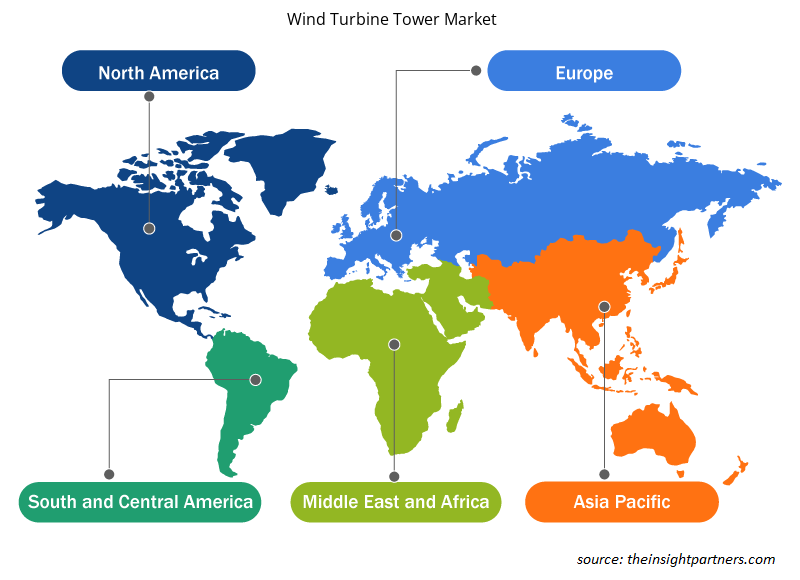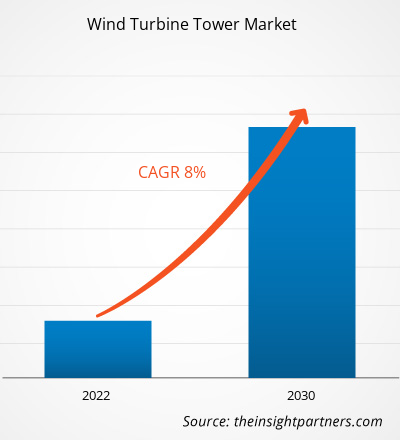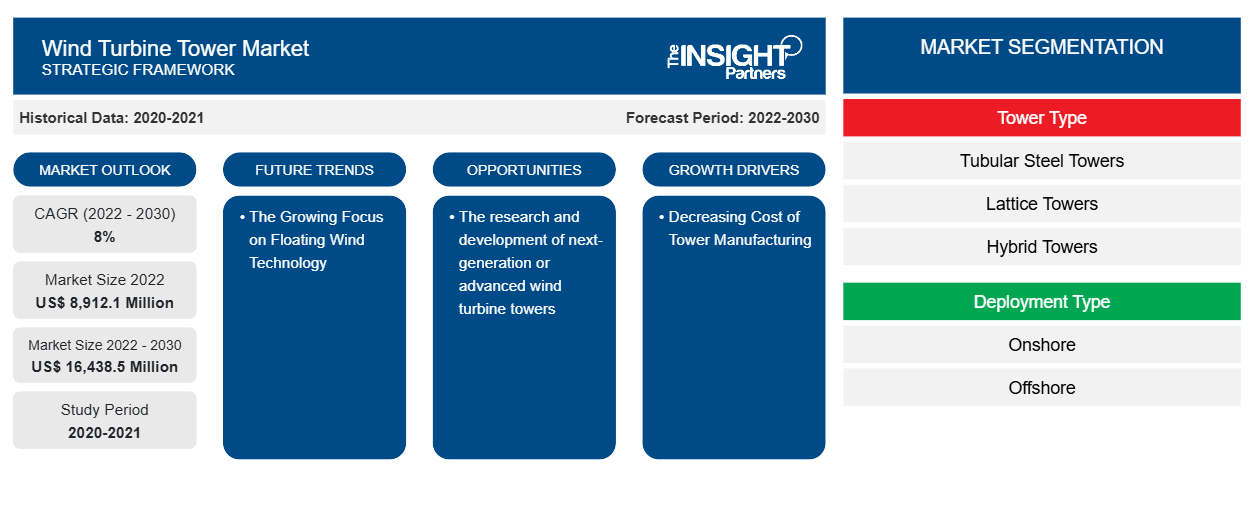2022 年风力涡轮机塔架市场价值为 89.121 亿美元,预计到 2030 年将达到 164.385 亿美元;预计 2022-2030 年期间的复合年增长率为 8%。下一代或先进风力涡轮机塔架的研发可能仍是市场的主要趋势。
风力涡轮机塔架市场分析
由于陆上和海上风力发电项目数量不断增加,尤其是在偏远地区,预计全球风力涡轮机塔市场将在分析的时间范围内经历显著增长。此外,政府通过专注于利用风能、太阳能、地热能等可再生能源发电来减少碳排放的法规预计将推动 2022 年至 2030 年的市场增长。此外,政府在全球范围内安装风力发电场的举措预计将在未来几年推动市场增长。
风力涡轮机塔架市场概况
随着人口和工业化的不断增长,全球对能源的需求也在不断增加。能源消耗的增加也推动了发展中国家和发达经济体对可再生能源发电的需求。这导致全球对风力发电基础设施的需求增加。与其他可再生能源相比,风力发电在世界范围内具有很高的重要性和可接受性。风力发电叶片、涡轮机、基础、涡轮机塔架、轴和其他部件的设计和开发技术的先进发展,促进了风能的采用和从可用风能中获得最大功率的重大进步。根据国际可再生能源机构 (IRENA) 的数据,到 2023 年底,全球风电装机容量将从 2021 年的 825 吉瓦达到 1,017 吉瓦。因此,由于风能的优势以及优惠的政策、激励措施和退税,预计未来几年风电装机容量将增加。全球风电装机容量的这种增长预计将成为风力涡轮机塔市场的主要驱动力。
定制此报告以满足您的需求
您可以免费定制任何报告,包括本报告的部分内容、国家级分析、Excel 数据包,以及为初创企业和大学提供优惠和折扣
-
获取此报告的关键市场趋势。这个免费样品将包括数据分析,从市场趋势到估计和预测。
风力涡轮机塔架市场驱动因素和机遇
降低塔制造成本以利于市场
风力涡轮机塔架主要由钢材制成,约占涡轮机总成本的 66-79%,其次是玻璃纤维、塑料或树脂(11-16%)、铁(5-17%)以及铜和铝(1-2%)。风力涡轮机塔架主要由钢材制成。预计商业和技术的不断进步将降低风力涡轮机塔架的制造成本。中国国内市场对钢材的需求不稳定以及中国钢材出口的增加正在影响全球钢材价格。钢材价格的持续下滑正在降低风电项目的整体运营费用。风能项目运营成本的下降对风能行业产生了积极影响,从而推动了对风力涡轮机塔架的需求。
浮动风电技术日益受到关注
浮动风电技术是将海上风力涡轮机安装在海上浮动结构上,以确保涡轮机在深水中发电。浮动或海上风电技术在恶劣的环境条件下效率很高,因此能够产生巨大的电力。这种浮动风电技术在全球多个国家采用,例如中国、德国、日本、英国、法国、比利时和丹麦。浮动风电技术应用的增长前景主要归因于技术进步、相关优势以及各种服务提供商提供的交钥匙解决方案的增加。各国对实现清洁能源目标的认识日益提高,推动了对浮动海上风电的需求,这为风力涡轮机塔市场的增长带来了潜在机会。
浮动海上风电卓越中心报告确定了 22 个最有可能成为新兴可再生能源技术主要参与者的国家。2022 年 1 月,英国政府宣布了 11 个可再生能源项目,每个项目将获得高达 9.5923 亿美元的奖励,并投入 29.7 亿美元来促进英国的可再生能源发电。预计全球对海上或浮动风电技术的此类投资将在未来几年推动市场增长。
风力涡轮机塔架市场报告细分分析
风力涡轮机塔架市场分析的关键部分是塔架类型和部署类型
- 根据塔架类型,风力涡轮机塔架市场分为钢管塔架、格构塔架和混合塔架。钢管塔架部分在 2022 年占据了较大的市场份额。
- 根据部署类型,市场分为陆上和海上。2022 年,陆上部分占据了更大的市场份额。
风力涡轮机塔架市场份额按地区分析
风力涡轮机塔架市场报告的地理范围主要分为五个区域:北美、亚太、欧洲、中东和非洲、南美和中美。
2022 年,亚太地区主导了风力涡轮机塔架市场。亚太地区包括中国、澳大利亚、印度、韩国、日本和亚太地区其他地区。亚太地区引领风力涡轮机塔架市场,因为它越来越注重将可再生能源资源整合到整体电力结构中,并致力于减轻化石燃料造成的环境污染。中国在全球风电市场中占据领先地位,无论是陆上风电还是海上风电。涡轮机塔架制造商对供应链生态系统的日益关注也极大地推动了整个风力涡轮机塔架市场的增长。通过资助可再生能源项目、补贴和政策,鼓励使用清洁能源资源而不是传统能源发电的积极态度日益增强,推动了印度和澳大利亚对风力涡轮机塔架的需求。
风力涡轮机塔架市场区域洞察
Insight Partners 的分析师已详尽解释了预测期内影响风力涡轮机塔架市场的区域趋势和因素。本节还讨论了北美、欧洲、亚太地区、中东和非洲以及南美和中美洲的风力涡轮机塔架市场细分和地理位置。

- 获取风力涡轮机塔架市场的区域特定数据
风力涡轮机塔架市场报告范围
| 报告属性 | 细节 |
|---|---|
| 2022 年市场规模 | 89.121亿美元 |
| 2030 年市场规模 | 164.385 亿美元 |
| 全球复合年增长率(2022 - 2030 年) | 8% |
| 史料 | 2020-2021 |
| 预测期 | 2022-2030 |
| 涵盖的领域 |
按塔类型
|
| 覆盖地区和国家 |
北美
|
| 市场领导者和主要公司简介 |
|
风力涡轮机塔架市场参与者密度:了解其对业务动态的影响
风力涡轮机塔架市场正在快速增长,这得益于终端用户需求的不断增长,而这些需求又源于消费者偏好的不断变化、技术进步以及对产品优势的认识不断提高等因素。随着需求的增加,企业正在扩大其产品范围,进行创新以满足消费者的需求,并利用新兴趋势,从而进一步推动市场增长。
市场参与者密度是指在特定市场或行业内运营的企业或公司的分布情况。它表明相对于给定市场空间的规模或总市场价值,有多少竞争对手(市场参与者)存在于该市场空间中。
在风力涡轮机塔架市场运营的主要公司有:
- 维斯塔斯风力系统公司
- 西门子歌美飒可再生能源
- 南非
- 瓦洛蒙特工业公司
- 公司
- 马曼公司
免责声明:上面列出的公司没有按照任何特定顺序排列。

- 了解风力涡轮机塔架市场的主要参与者概况
风力涡轮机塔架市场新闻和最新发展
风力涡轮机塔架市场的评估是通过收集一手和二手研究后的定性和定量数据进行的,其中包括重要的公司出版物、协会数据和数据库。风力涡轮机塔架市场的一些发展情况如下:
- GreenerTower 已经完成了第一笔订单。RWE 和西门子歌美飒同意在丹麦 1,000 兆瓦 Thor 海上风能项目中推出 36 台 GreenerTower。总共计划从 2026 年开始安装约 72 台 SG 14-236 DD 海上风力涡轮机。(来源:西门子歌美飒可再生能源公司,新闻稿,2023 年 4 月)
- 全球可再生能源领导者 Orsted 和 Vestas 宣布建立商业可持续发展合作伙伴关系。预计 Ørsted 将在所有联合海上风电项目中从 Vestas 采购由再生材料制成的低碳钢风力涡轮机塔架和转子叶片。(来源:NN, Inc,新闻稿,2023 年 6 月)
风力涡轮机塔架市场报告范围和交付成果
“风力涡轮机塔架市场规模和预测(2020-2030 年)”报告对以下领域进行了详细的市场分析:
- 风力涡轮机塔架市场规模及全球、区域和国家层面所有主要细分市场的预测
- 风力涡轮机塔架市场趋势以及市场动态,如驱动因素、限制因素和关键机遇
- 详细的 PEST 和 SWOT 分析
- 风力涡轮机塔架市场分析涵盖主要市场趋势、全球和区域框架、主要参与者、法规和最新市场发展
- 行业格局和竞争分析,涵盖市场集中度、热点图分析、知名参与者以及风力涡轮机塔架市场的最新发展
- 详细的公司简介
- 历史分析(2 年)、基准年、预测(7 年)及复合年增长率
- PEST和SWOT分析
- 市场规模、价值/数量 - 全球、区域、国家
- 行业和竞争格局
- Excel 数据集
近期报告
相关报告
客户评价
购买理由
- 明智的决策
- 了解市场动态
- 竞争分析
- 客户洞察
- 市场预测
- 风险规避
- 战略规划
- 投资论证
- 识别新兴市场
- 优化营销策略
- 提升运营效率
- 顺应监管趋势























 获取免费样品 - 风力涡轮机塔市场
获取免费样品 - 风力涡轮机塔市场